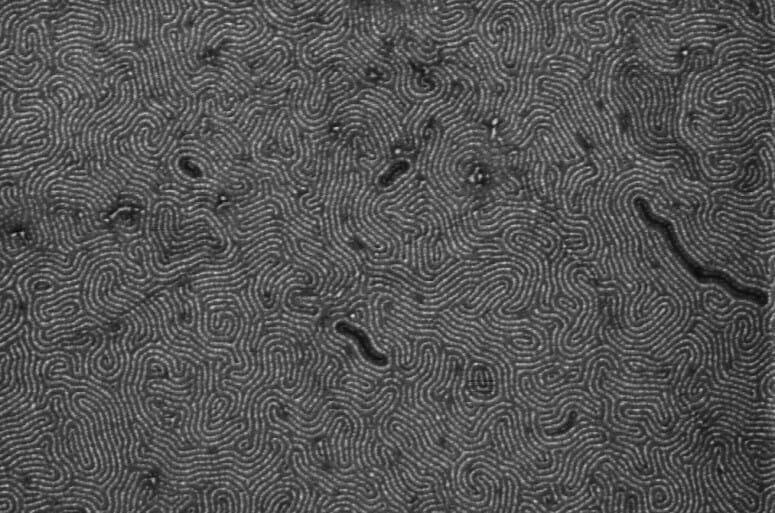May 4 2021
Telecommunications transmissions, right from radio and television to the internet, are only data transmitted by light waves and changed into electrical signals.
 University of Wisconsin–Madison researchers produced the smallest ribbons of graphene yet created, at about 12 nm in width, in efforts to use the all-carbon, ultra-thin, and adaptable material to improve internet and other kinds of telecommunications performance. The structures, which act like tiny antennas that interact with light, are too small to see with the naked eye. Image Credit: University of Wisconsin–Madison.
University of Wisconsin–Madison researchers produced the smallest ribbons of graphene yet created, at about 12 nm in width, in efforts to use the all-carbon, ultra-thin, and adaptable material to improve internet and other kinds of telecommunications performance. The structures, which act like tiny antennas that interact with light, are too small to see with the naked eye. Image Credit: University of Wisconsin–Madison.
At present, silicon-based fiber optics are the most ideal structures for long-distance, high-speed transmissions; however, graphene—an adaptable, ultra-thin, and all-carbon material—may further enhance the performance.
Now, for the first time, researchers from the University of Wisconsin–Madison (UW-Madison) have designed graphene into the tiniest ribbon structures by using a technique that makes it easy to scale up. The study was recently published in the ACS Photonics journal on April 16th, 2021.
While testing these tiny ribbons, the researchers found that they were almost zeroing in on the properties required to move graphene toward useful applications in telecommunication systems.
Previous research suggested that to be viable for telecommunication technologies, graphene would need to be structured prohibitively small over large areas, (which is) a fabrication nightmare. In our study, we created a scalable fabrication technique to make the smallest graphene ribbon structures yet and found that with modest further reductions in ribbon width, we can start getting to telecommunications range.
Joel Siegel, Study Co-Lead Author, University of Wisconsin–Madison
Siegel is also a UW-Madison graduate student in physics professor Victor Brar’s team.
Graphene is considered a wonder material for many technologies, such as solar cells or telecommunications, because it is relatively cheap, easy to work with, and has special physical properties, for example, it is both a conductor and insulator of electricity.
If graphene is altered to communicate with the higher energy of light, it can possibly be used to control telecommunications signals at ultra-speeds. For instance, the modified graphene could be used to inhibit unnecessary communications frequencies.
One way to enhance the performance of graphene is to cut it into tiny, nanometer-scale ribbon structures, which serve as small antennas that communicate with light. If the antenna is smaller, it will interact with higher energies of light. Moreover, the antenna can be “tuned” to communicate with various light energies upon applying an electric field, thus expanding its performance even more.
The investigators, including teams headed by Michael Arnold and Padma Gopalan, both materials science and engineering professors from UW–Madison, initially set out to develop a graphene ribbon device that is narrower than anything created so far.
When the researchers constructed ribbon-shaped polymers above the graphene and etched away some of the surrounding material, they obtained accurately drawn, extremely thin graphene ribbons.
It’s very useful because there are not good fabrication techniques to get down to the feature size we did, 12 nanometers wide over a large area. And there is no difference between patterning over the centimeter-scale we’re working with here and giant six-inch wafers useful for industrial applications. It’s very easy to scale up.
Joel Siegel, Study Co-Lead Author, University of Wisconsin–Madison
With the fabricated devices, the team can subsequently test the interaction between the graphene ribbons and light and how well these ribbons could regulate that interaction.
Along with the team of Mikhail Kats, an electrical and computer engineering professor from UW–Madison, the researchers shined varied wavelengths of infrared light into the structures and detected the wavelength where interactions between the ribbons and light were extremely strong, also called the resonant wavelength.
The team observed that as the width of the ribbon reduces, the resonant wavelength of light also reduces. Lower wavelengths translate to higher energies, and the researchers’ devices communicated with the highest energies ever measured for structured graphene.
The team successfully tuned the ribbons by raising the strength of the electric field applied to the structures, and this additionally reduced the resonant wavelength of the structures. The investigators determined that a certain structure has the predicted flexibility required for the technology applications they were working to realize.
They subsequently compared their experimental data with the anticipated behaviors of the structured graphene over three different widths of ribbons and three different strengths of the electric field. The wider ribbons produced by the team closely corresponded with the anticipated behaviors.
However, in the case of narrower ribbons, the team observed a so-called blueshift, or a shift to higher-than-predicted energies. This blueshift can be described by the fact that electrons within the smaller ribbons would probably interact with—and repel—one another.
The blueshift we observed indicates that telecommunications wavelengths can be reached with much larger structures than previously expected—around eight-to-10 nanometers—which is only marginally smaller than the 12 nanometers structures we made.
Joel Siegel, Study Co-Lead Author, University of Wisconsin–Madison
With the 8-to-10 nm goal looming much closer than anticipated, the team is currently trying out new ways to tune their fabrication techniques to render the ribbons even narrower. Such novel graphene nanostructures will also enable scientists to investigate the underlying physics of interactions between light and matter—a study that Siegel and collaborators are now pursuing.
The study was funded by the Defense Advanced Research Projects Agency (YFA D18AP00043), SNM-IS (1727523), U.S. Army Research Office (W911NF-12-1-0025 and W911NF-18-1-0149), the Air Force Office of Research (FA9550-18-1-0146), and the U.S. Department of Energy (DE-SC0016007).
Journal Reference:
Siegel, J. F., et al. (2021) Using Bottom-Up Lithography and Optical Nonlocality to Create Short-Wave Infrared Plasmonic Resonances in Graphene. ACS Photonics. doi.org/10.1021/acsphotonics.1c00149.